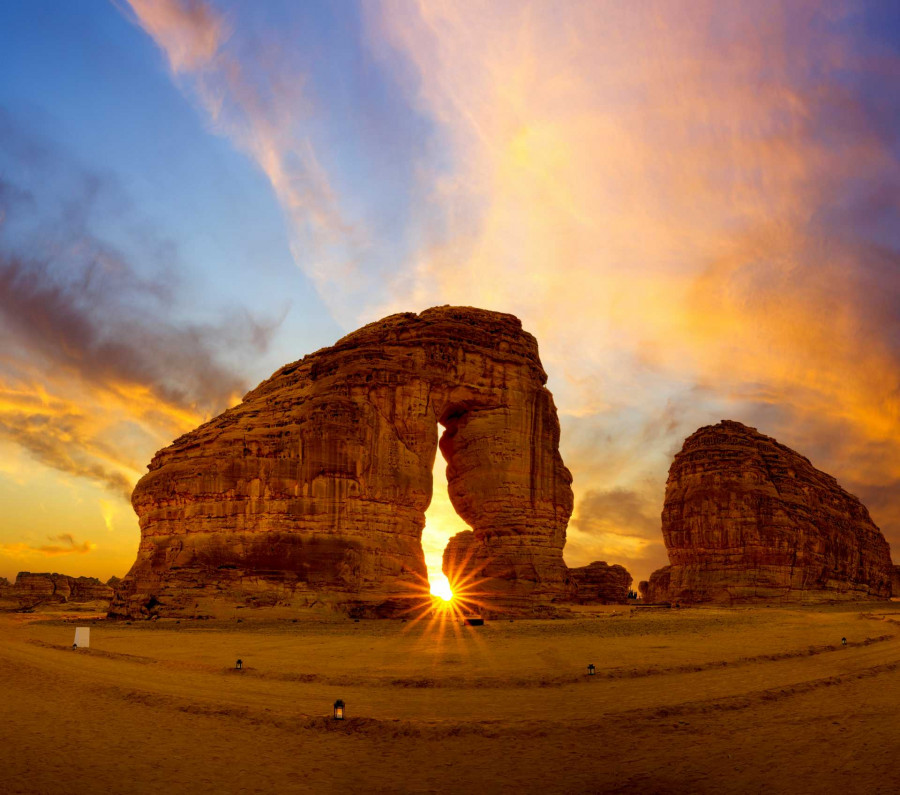
Nestled amidst the rugged beauty of the Sarawat Mountains, Al Ula emerges as a captivating jewel in the crown of Saudi Arabia. Known for its stunning landscapes, moderate climate, and rich historical heritage, Al Ula beckons travelers to immerse themselves in its timeless allure.
Perched at an elevation that offers breathtaking views, Al Ula boasts a temperate climate, making it a sought-after retreat for those seeking solace from the intense heat prevalent in much of the region. The city’s unique blend of natural wonders, including awe-inspiring rock formations and verdant oases, paints a canvas of tranquility that captivates the hearts of all who venture into its embrace.
Location of Al Ula
Al Ula is strategically situated in the northwestern part of Saudi Arabia, nestled within the majestic Sarawat Mountains. Geographically, it lies approximately 300 kilometers (186 miles) north of the city of Medina. The elevated terrain not only contributes to the city’s moderate climate but also sets the stage for a stunning backdrop of mountains, canyons, and archaeological wonders.
As you journey to Al Ula, the road unfolds a mesmerizing landscape, revealing the natural beauty that defines this historical destination. Whether you arrive by road or air, the approach to Al Ula sets the tone for an unforgettable exploration of the treasures hidden within its ancient valleys.
The History of Al Ula
Al Ula’s history is a tapestry woven with threads of ancient civilizations, cultural exchange, and a rich legacy that spans millennia. The city’s roots date back to prehistoric times, with evidence of human habitation found in archaeological sites that reveal the region’s early significance.
In the 7th century, Al Ula gained historical prominence as a crucial stop on the trade routes connecting the Arabian Peninsula to Mesopotamia and beyond. The city’s strategic location made it a crossroads for commerce and cultural exchange, leaving an indelible mark on its character.
Throughout the centuries, Al Ula flourished as a center for agriculture, trade, and pilgrimage. Pilgrims traveling to and from Mecca often passed through the city, contributing to its cultural diversity and economic prosperity. The city’s ancient mud-brick buildings, known as “qasr,” stand as silent witnesses to the passage of time and the endurance of Al Ula’s architectural heritage.
In the 21st century, Al Ula has become a focal point for heritage preservation and sustainable tourism. Efforts to showcase its historical sites, including the UNESCO World Heritage Site Madain Saleh, reflect a commitment to honoring the city’s past while embracing its future.
Al Ula’s Significance
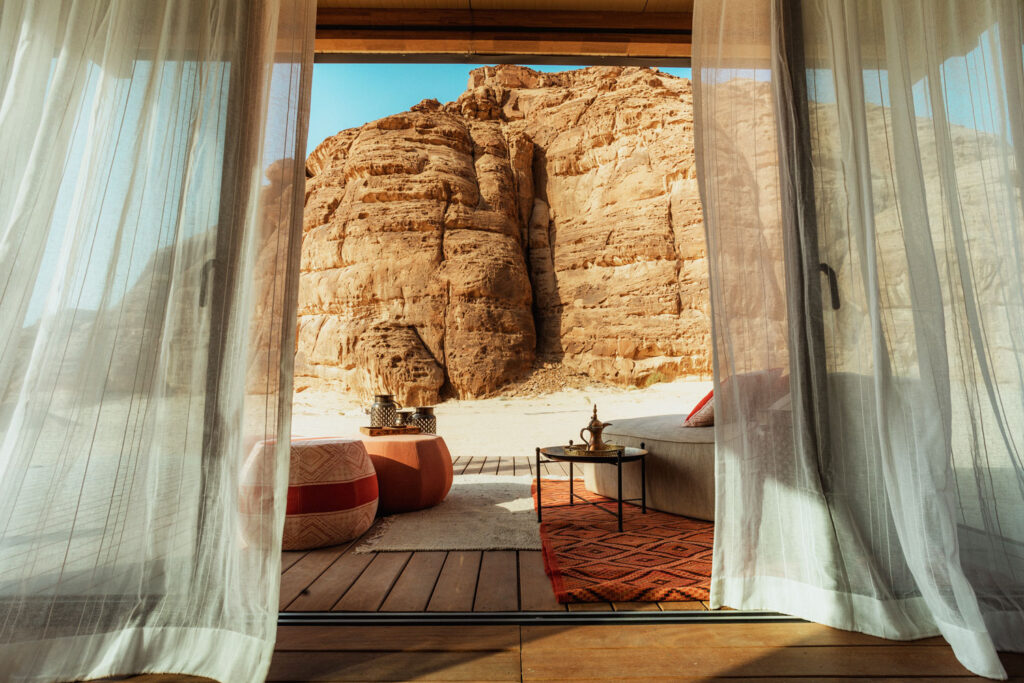
Al Ula, with its compelling history and breathtaking landscapes, holds profound significance that extends beyond its geographical boundaries.
- Archaeological Treasure:
Al Ula is home to Madain Saleh, also known as Al-Hijr, a UNESCO World Heritage Site that features spectacular rock-cut tombs and Nabatean architecture. This archaeological treasure, reminiscent of Petra in Jordan, showcases the city’s role in ancient trade routes and the cultural exchange between Arabian, Egyptian, Hellenistic, and Mesopotamian civilizations. - Cultural Crossroads:
Situated at the crossroads of ancient trade routes, Al Ula emerged as a melting pot of cultures and influences. The city’s architectural marvels, including the intricate carvings of Madain Saleh, reflect the diverse artistic and cultural elements that have shaped its identity. - Natural Beauty and Oases:
Al Ula’s stunning natural landscapes, characterized by towering sandstone formations and lush oases, contribute to its allure. The contrast between the golden desert sands and the greenery of the oasis creates a visual symphony that captivates visitors, offering a serene escape into nature. - Trade and Commerce:
Throughout history, Al Ula served as a vital hub for trade and commerce. The city’s strategic location on the Incense Route connected it to major trade centers, facilitating the exchange of goods, ideas, and cultural practices. Al Ula’s economic significance remains embedded in its historical streets and marketplaces. - Modern-Day Marvels:
Al Ula’s commitment to preserving its historical sites while embracing modernity reflects its significance in contemporary Saudi Arabia. The city’s transformation into a sustainable tourism destination underscores its cultural and environmental importance.
Al Ula is not merely a city; it is a living testament to the resilience of human civilization, the beauty of nature, and the enduring spirit of a place that has played a pivotal role in shaping the history of the Arabian Peninsula.
Climate of Al Ula
Al Ula’s climate provides a refreshing departure from the scorching temperatures associated with many parts of Saudi Arabia. The city’s elevation in the Sarawat Mountains contributes to its moderate climate, creating an environment that beckons visitors throughout the year.
- Moderate Temperatures:
Al Ula experiences mild to warm temperatures, with summers being relatively more bearable compared to other regions. Daytime temperatures typically range from 25 to 35 degrees Celsius (77 to 95 degrees Fahrenheit) during the summer months, offering a comfortable atmosphere for exploration. - Pleasant Winters:
Winters in Al Ula are characterized by mild daytime temperatures ranging from 10 to 20 degrees Celsius (50 to 68 degrees Fahrenheit). The cooler evenings add a touch of crispness to the air, creating an ideal climate for outdoor activities and exploration. - Seasonal Contrasts:
The changing seasons in Al Ula bring about subtle contrasts in the landscape. Spring, in particular, transforms the region with blossoming flowers and a burst of colors, enhancing the visual appeal of the city’s natural wonders. - Ideal for Exploration:
Al Ula’s climate provides an ideal backdrop for exploring its archaeological sites, hiking through the mountains, and immersing oneself in the beauty of its oases. The temperate weather enhances the overall experience, allowing visitors to fully appreciate the historical and natural wonders of the city.
In essence, Al Ula’s climate, combined with its historical significance and natural beauty, creates a harmonious setting that invites travelers to embark on a journey through time and nature.
Sites and People of Al Ula
Nestled amidst the rugged beauty of the Sarawat Mountains, Al Ula stands as a mesmerizing jewel in the crown of Saudi Arabia. Known for its captivating landscapes, rich cultural heritage, and ancient wonders, Al Ula is a city that beckons travelers to explore the tales woven into its sites and the warmth of its people.
- Architectural Splendors:
The cityscape of Al Ula is adorned with architectural marvels that trace their roots through different eras and civilizations. Al Ula’s rock-cut tombs, such as those in Madain Saleh (Hegra), stand as a testament to the Nabataean civilization, showcasing intricate details and a mastery of stonework. The ancient city’s architecture mirrors the cultural richness that has shaped Al Ula’s identity. - Souq Al Ula:
A marketplace echoing the traditions of ancient times, Souq Al Ula embodies the vibrant spirit of the city. Once a hub for traders along the Incense Route, the souq continues to captivate with its traditional crafts, spices, and local wares. As visitors wander through its lanes, the lively atmosphere mirrors the enduring vitality of Al Ula’s commercial and cultural heritage. - Natural Retreats:
Al Ula’s people find solace in the city’s natural wonders, surrounded by the striking landscapes of rock formations, expansive deserts, and historic oases. Locals and visitors alike gather to appreciate the beauty of the surroundings, engaging in activities like hiking, picnicking, and marveling at the breathtaking scenery of sites such as Elephant Rock and Al Ula Oasis. - Warm Hospitality:
The people of Al Ula are celebrated for their warm hospitality and welcoming demeanor. Whether exploring the ancient tombs or strolling through the vibrant souq, visitors are met with genuine kindness. The locals take pride in sharing their cultural heritage, offering insights into traditional practices, and creating an atmosphere that fosters a sense of community. - Al Ula Arts Festival:
An annual celebration that encapsulates the essence of Al Ula, the Arts Festival is a testament to the city’s commitment to cultural richness. The event showcases local and international artists, reflecting the deep connection between the people of Al Ula and the arts. It is a time when the community comes together to honor their traditions and share the beauty of creativity.
In the heart of Al Ula, the sites and people seamlessly intertwine, creating an immersive experience for those who venture into this historical haven. From the echoes of ancient civilizations to the contemporary vibrancy of the city, Al Ula invites travelers to become part of its living history, where every step unveils a new layer of cultural richness and natural splendor.
Best Attractions in Al Ula
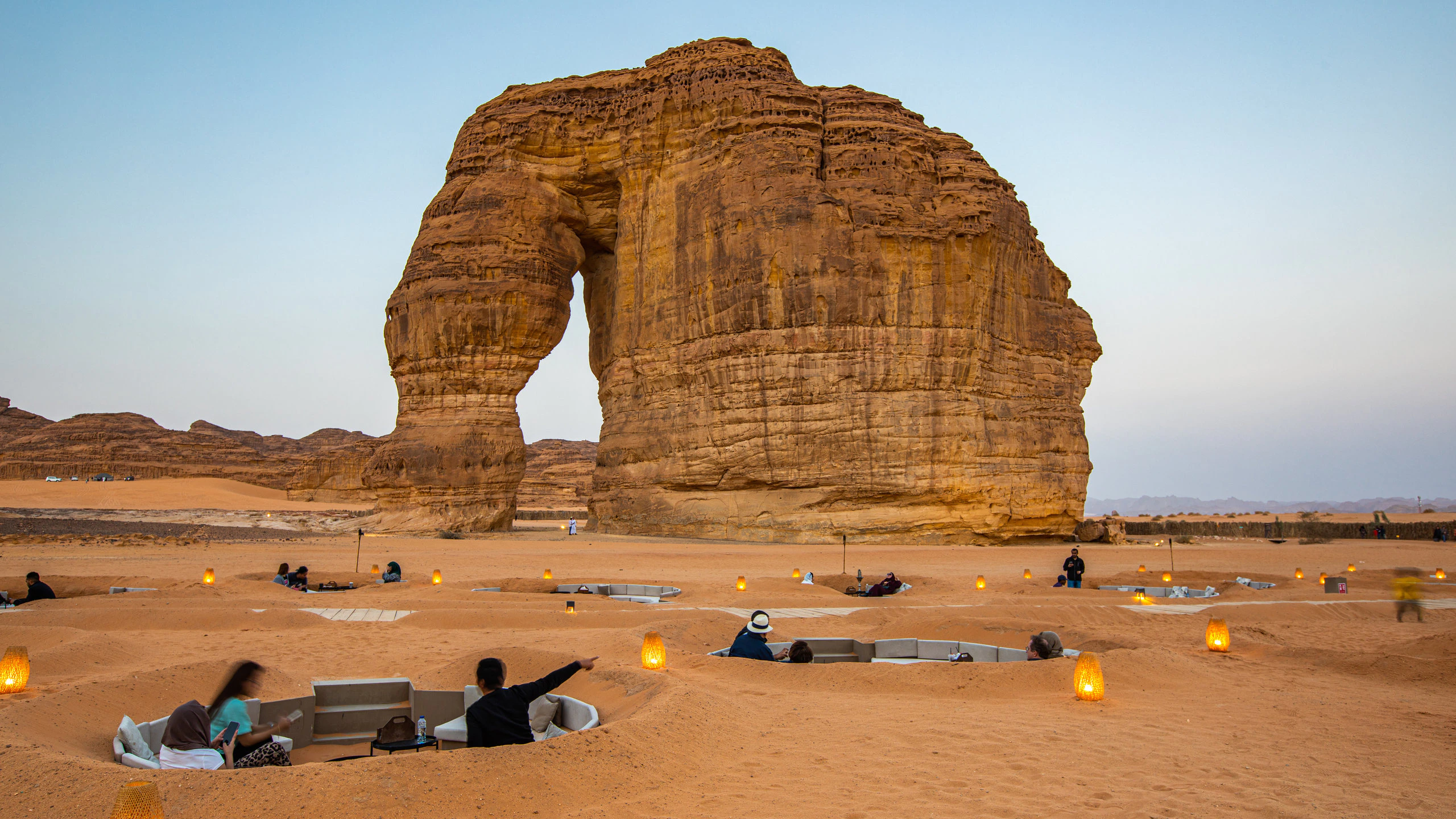
Al Ula, with its blend of historical significance, natural beauty, and cultural richness, offers a treasure trove of attractions that beckon travelers to explore its enchanting landscapes. From ancient tombs to rock formations, here are some of the best attractions that make Al Ula an unforgettable destination:
- Madain Saleh (Hegra):
Step into the ancient world with a visit to Madain Saleh, also known as Hegra. This UNESCO World Heritage Site features rock-cut tombs and archaeological wonders that mirror the grandeur of the Nabataean civilization. Explore the intricacies of the tombs and immerse yourself in the historical tapestry of Madain Saleh. - Elephant Rock:
Marvel at the natural wonders of Al Ula with a visit to Elephant Rock. This distinctive rock formation, resembling an elephant standing on its hind legs, is a testament to the city’s geological marvels. The site offers a unique backdrop for exploration and photography, allowing visitors to witness the beauty sculpted by nature. - Al Ula Oasis:
Discover the historic oasis of Al Ula, a lush haven amidst the arid surroundings. The oasis has been a vital source of life for centuries, providing water and sustenance to the locals. Take a leisurely stroll through the palm groves, appreciate the traditional falaj irrigation system, and experience the timeless allure of Al Ula Oasis. - Dadan Archaeological Site:
Uncover the mysteries of Dadan, an ancient city with a rich history dating back to the 6th century BCE. The archaeological site features remnants of walls, gates, and inscriptions, offering a glimpse into the prosperity and cultural heritage of the Dadanite civilization. Explore the archaeological wonders that highlight Al Ula’s significance in the region. - Al Diwan and Jabal Ikmah:
Visit Al Diwan and Jabal Ikmah to witness the rock inscriptions and petroglyphs that tell the stories of ancient civilizations. The inscriptions provide valuable insights into the cultural practices, trade routes, and daily life of the people who once inhabited this region. Explore the outdoor gallery of history etched into the rocks. - Al Ula Old Town:
Wander through the historic streets of Al Ula Old Town, where mud-brick buildings and ancient architecture evoke a sense of nostalgia. The town reflects the traditional way of life in the region and offers a charming backdrop for cultural exploration. Experience the authentic ambiance of Al Ula’s heritage in its oldest quarters. - Mount Athlab:
For panoramic views of Al Ula and its surroundings, venture to Mount Athlab. A hike or a scenic drive to the summit unveils breathtaking landscapes and overlooks. The elevated vantage point provides a unique perspective of the city, allowing visitors to appreciate the natural beauty that defines Al Ula.
From the ancient wonders of Madain Saleh to the geological marvel of Elephant Rock, Al Ula unfolds its treasures to those eager to explore. Each attraction contributes to the city’s multifaceted allure, inviting visitors to unravel the layers of history, culture, and natural beauty that define this jewel in the Sarawat Mountains.
Best Things to Do In Al Ula
Al Ula, with its ancient wonders, natural marvels, and cultural richness, offers a plethora of experiences for every traveler seeking a blend of history, relaxation, and outdoor exploration. Here are the best things to do in Al Ula that promise to make your visit truly memorable:
- Explore Madain Saleh (Hegra):
Step back in time with a visit to Madain Saleh, exploring the rock-cut tombs and archaeological wonders of the Nabataean civilization. Take a guided tour to delve into the history of this UNESCO World Heritage Site, appreciating the intricate details and the grandeur of ancient architecture. - Witness the Sunset at Elephant Rock:
Experience the magic of the desert landscape by witnessing the sunset at Elephant Rock. The warm hues of the fading sunlight cast a mesmerizing glow on the distinctive rock formation. It’s an ideal spot for photography and a serene moment of reflection in the heart of Al Ula’s natural wonders. - Attend the Al Ula Arts Festival:
Immerse yourself in the vibrant cultural scene of Al Ula by attending the annual Arts Festival. The event showcases a fusion of local and international artistic expressions, from visual arts to performances. Engage with the creative spirit of Al Ula’s community and witness the transformative power of art. - Stroll Through Al Ula Oasis:
Escape the desert heat and discover the timeless beauty of Al Ula Oasis. Take a leisurely stroll through the palm groves, admire the traditional falaj irrigation system, and experience the serenity of this historic oasis. It’s a peaceful retreat that highlights the coexistence of nature and human ingenuity. - Hike to Jabal Ikmah:
Embark on a hiking adventure to Jabal Ikmah, a site adorned with ancient rock inscriptions and petroglyphs. The hiking trails offer a unique opportunity to explore the outdoor gallery of historical engravings, providing insights into the lives of ancient civilizations. Guided tours enhance the experience with informative narratives. - Discover Dadan Archaeological Site:
Uncover the secrets of the ancient city of Dadan at the archaeological site. Explore the remnants of walls, gates, and inscriptions that narrate the stories of the Dadanite civilization. A visit to Dadan provides a fascinating journey through time, connecting visitors with the rich history of Al Ula. - Visit Al Ula Old Town:
Take a leisurely stroll through the historic streets of Al Ula Old Town, where mud-brick houses and ancient architecture transport you to a bygone era. Experience the authenticity of Al Ula’s heritage in its oldest quarters, appreciating the traditional way of life that has endured through the centuries. - Experience the Night Sky at Al Ula:
Escape the city lights and marvel at the celestial wonders above Al Ula. The clear desert skies offer an ideal setting for stargazing. Join guided night sky tours to witness constellations, planets, and the Milky Way, immersing yourself in the tranquility of the desert night.
Al Ula’s diverse offerings ensure that every visitor finds something to suit their preferences. Whether you’re drawn to ancient history, cultural exploration, or simply unwinding in nature, Al Ula invites you to savor the richness of its experiences and create lasting memories in this historical and natural wonder.
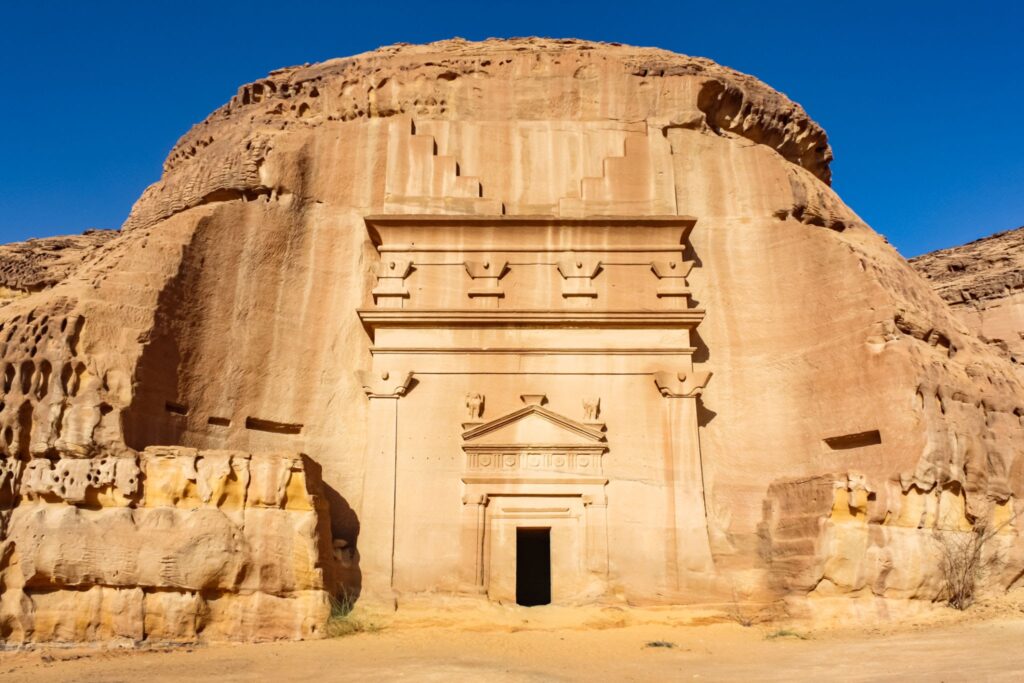
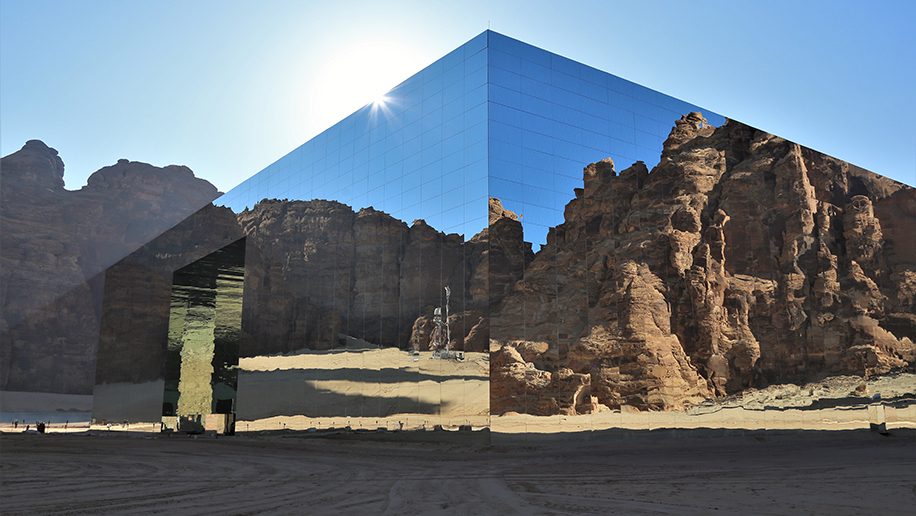
Al Ula Helicopter Tour – Saudi Arabia Tours
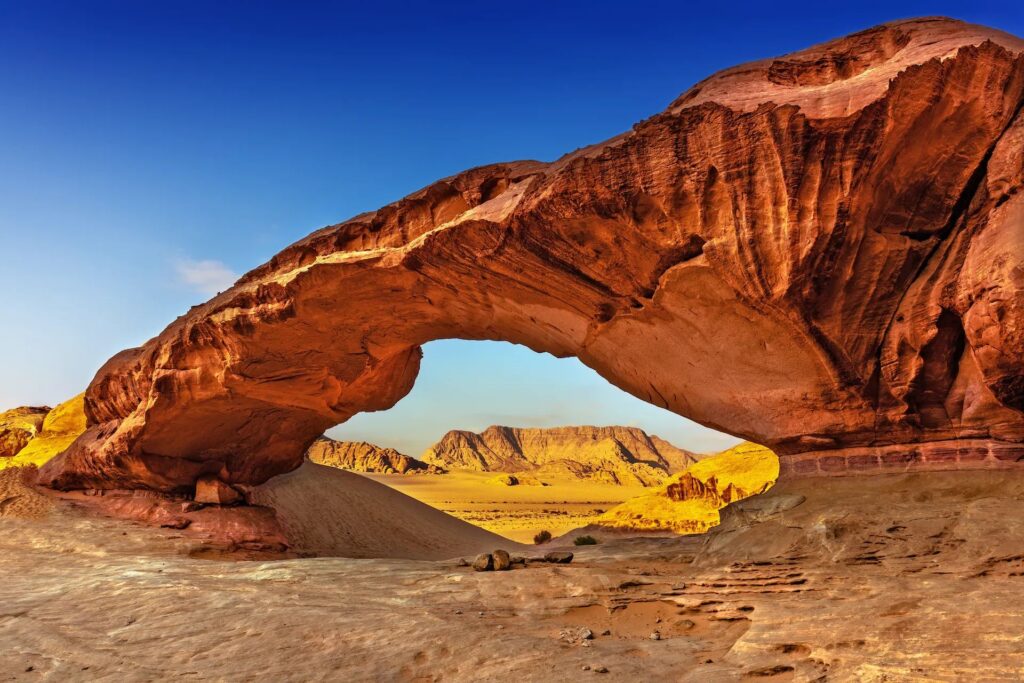
Wadi Al Disah Day Tour From Al Ula – Saudi Arabia Tours
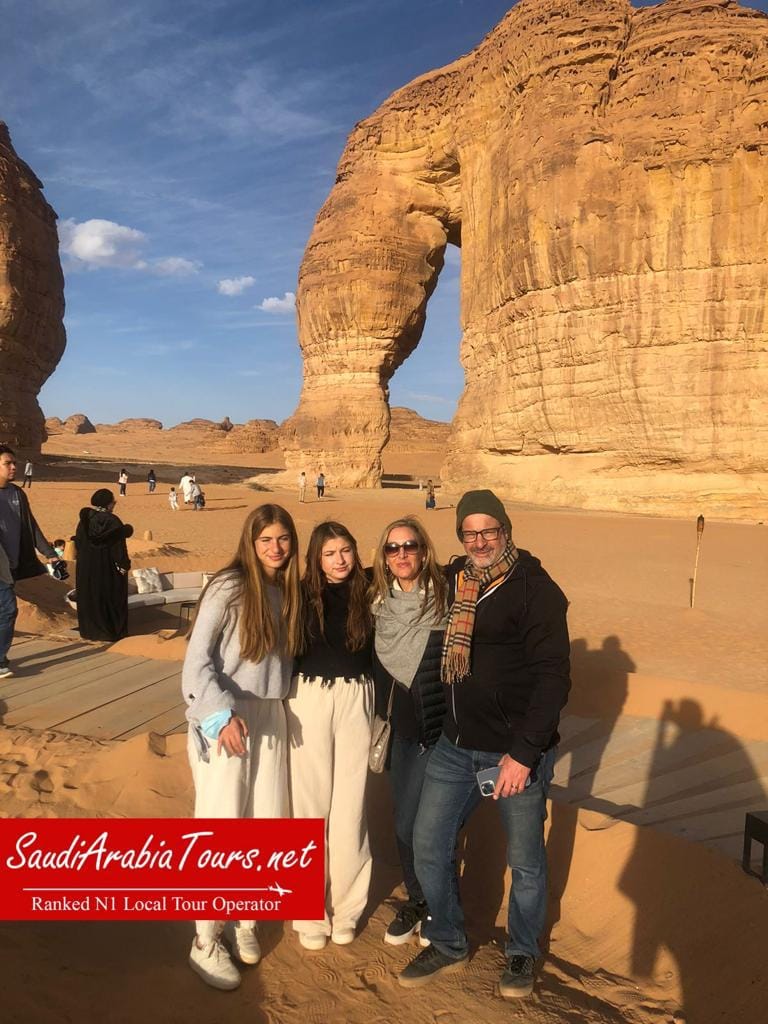
How Good are Saudi Arabia Tours?
Saudi Arabia Tours prides itself on being the best travel agency in Saudi Arabia as proven by our numerous positive reviews.
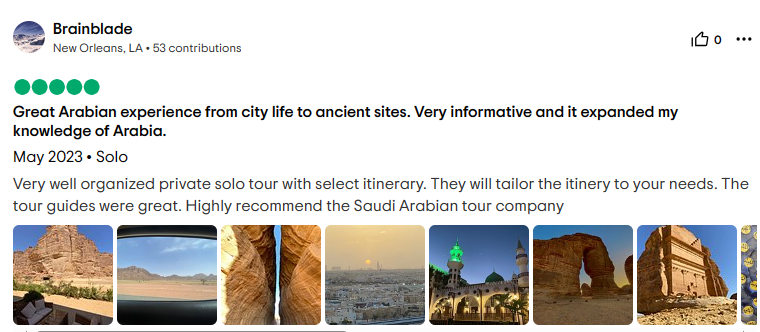
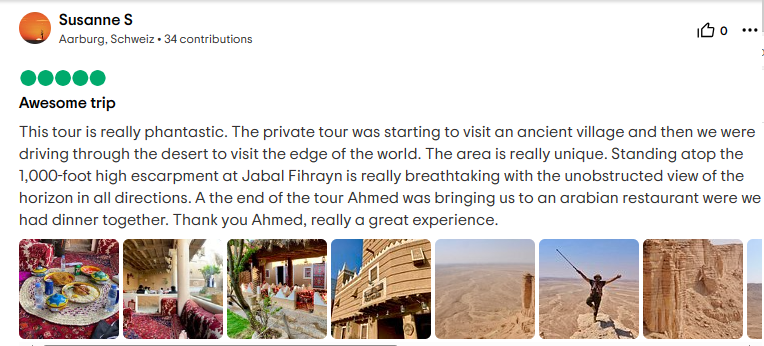

Frequently Asked Questions?
Is Saudi Arabia safe for tourists?
Tourists have been visiting Saudi Arabia and Saudi Arabians have a well-earned reputation for warmth and kindness toward visitors. Saudi Arabia cities are generally very safe, especially in areas where tourists frequent.
How to get a Saudi tourist visa?
Applying for a tourist visa to Saudi Arabia is easy. If you are from one of the 49 eligible countries, you can apply through the eVisa website. Holders of US, UK, or Schengen visas can apply for the visa upon arrival. Saudi Arabia is opening its doors to the world through its new tourist visa. Visitors will have the chance to discover and experience the warm hospitality of the Saudi people, the rich heritage, the vibrant culture, and Saudi Arabia’s diverse and breathtaking landscapes. The visa will be a one-year, multiple-entry visa, allowing tourists to spend up to 90 days in the country.
Are non-Muslims allowed in Saudi?
Non-Muslims can travel to all cities in Saudi Arabia except Medinah and Mekkah, Not allowed to non-Muslims to enter Mecca and Medinah.
Can I wear jeans in Saudi Arabia?
Both men and women are asked to dress modestly in public, avoiding tight-fitting clothing. Women should cover their shoulders and knees in public.
Contact us for more information on:
saudiarabiatours.net@gmail.com
Address: Head Office Olaya St, Riyadh 12213, Saudi Arabia.
If you are booking and taking the tour within 24 hours, or have an urgent request, call us on
Cell/whatsapp : +966558018938 For more info please visit Saudi Arabia Tours

